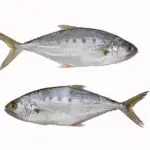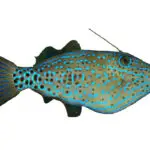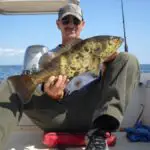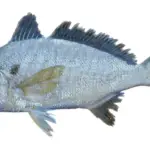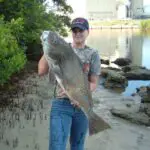If you’ve spent any time fishing or boating in the warm coastal waters of the United States (or around the world) you’ve probably encountered mullet.
In fact, Mullet are synonymous with coastal and brackish waterways, and a valuable commercial and recreational fish.
But what do mullet eat? Do they really eat algae? Or maybe you’ve heard they only eat mud?
The truth is, there is a lot of misinformation when it comes to mullet, and in this article, I’m going to clear things up and tell you exactly what mullet eat, where they feed, and how you can catch them or attract them.
Table of Contents
- What Do Mullet Eat In the Wild?
- How Do Mullet Feed?
- What Do Jumping Mullet Eat?
- What Is The Best Bait For Mullet?
- What Do Fish Farm Mullet Feed On?
- Related Posts
What Do Mullet Eat In the Wild?
Mullet are diurnal feeders and primarily feed on detritus (decaying organic matter found in the water), zooplankton, and small marine life such as copepods and fish larvae. They have a unique stomach gizzard that allows them to consume and process sand and sediment.
Basically, mullet are opportunistic feeders who will take advantage of what is readily available.
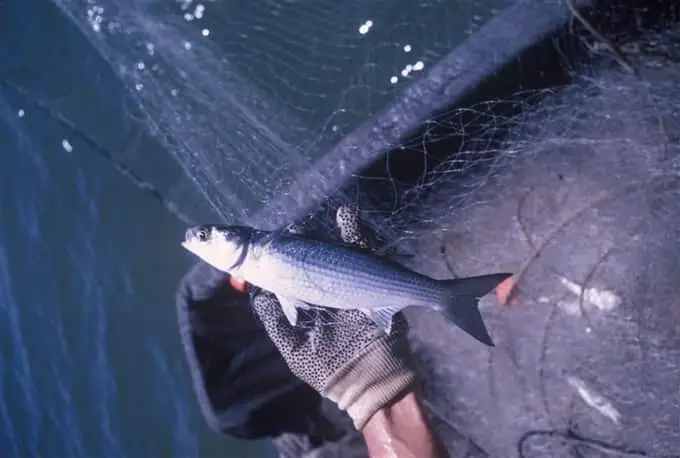
Marine Vegetation
Mullet munch on a host of plants that grow on the ocean floor, including seaweed, green sea lettuce, algae, diatoms, and decaying leaves.
Do Mullet Eat Grass?
Seagrass varieties like shoal grass, manatee grass, and turtle grass are common habitats for mullet, where they can be seen feeding and schooling.
Detritus
Detritus is the organic matter produced after the decomposition of dead organisms in the water.
This organic matter settles or drifts around on the seabed and often ges lodged on rocks, plants, and other structures where mullet feed.
Do Mullet Eat Algae?
Mullet are often seen ‘slurping‘ along the water surface eating microalgae and surface scum.
Do Mullet Eat Shrimp?
Small crustaceans like copepod, mantis shrimp, krill, and prawn are a mullet delicacy, and they will swallow them whole. Micro crustaceans actually contribute a large percentage of the mullet diet in the larval stage.
These shrimp-like crustaceans are present in plankton which mullet thrive on.
Do Mullet Eat Insects?
Mullet will not discriminate between the insects and larvae; they offer equally satisfying feasting opportunities and are abundant in the water.
They love maggots, and anglers use this information to catch them all the time. Caddisflies, lacewings, and fishflies are all candidates for larvae and will even be eaten on the surface by mullet. Anglers use ragworms as bait to entice mullet when maggots are unavailable.
Do Mullet Eat Meat?
Mullet do eat meat, however, this is almost exclusively from dead or decaying fish and marine life found in the water column and bottom sediment.
Mullet do not eat live baitfish or hunt for food, however, anglers have reported catching mullet on small pieces of meat such as hot dogs, chicken livers, and fish scraps.
How Do Mullet Feed?
Mullet will adapt how they feed to suit what they are feeding on at the time. They are backed by a thick-walled gizzard-like stomach that helps them grind food. They also have a long gastrointestinal tract that is sufficient to process their expansive list of edibles.
- Mullet feed on the plankton carried along by tides or currents. They are filter eaters and swim against the current, skimming food from plankton and filtering out the inedible bits.
- They also nibble on seaweed, algae, and other marine vegetation. Using their spade-shaped lower jaw, striped mullet will scrape material from rocks, pier support boards, walls, and wrecks. You can spot the grooves they make during low tide.
- When feeding on benthic organisms, mullet suck the top layer off detritus and microalgae or scoop seabed sediment, sand or mud into their mouth and consume the crustaceans and invertebrates using their teeth and gills to filter out the inedible items.
- Their appetite for solid food is appeased through scavenging rather than hunting. They are risk-averse and easily spooked, which is why they will often ignore bait presented to them. Mullet consume small pieces of dead fish and other animal matter on the seabed and occasionally dislodge and eat worms.
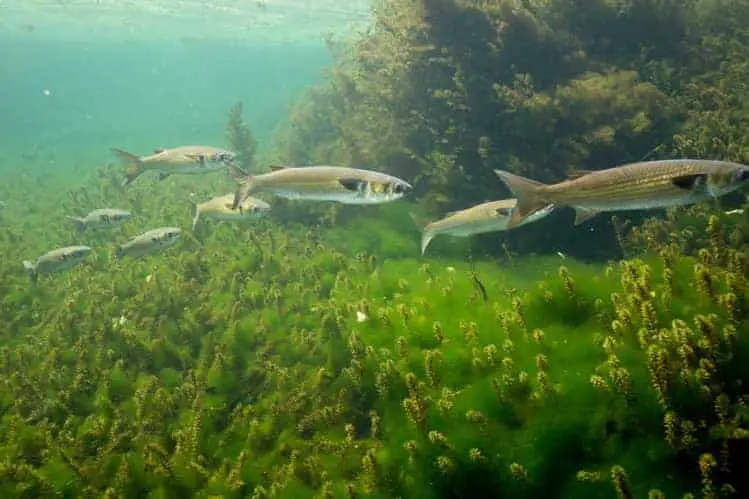
Mullet have tiny mouths which only allow them to eat small food morsels, whether they are nibbling, scooping from the seabed, or gulping against the tide.
If the pieces are too big, mullet will nibble on them, and you risk losing your bait without snaring them. Small pieces will encourage them to swallow, increasing the probability of a hookset.
Where Do Mullet Feed?
Mullet feed and school in shallow coastal waters, bays, and brackish rivers. They are commonly associated with mudflats, grass flats, mangrove estuaries, inlets, and sandy beaches.
You are much more likely to find mullet in shallow coastal waters, 15 feet deep or less. In my area, they are found inshore at the mouths of creeks near oyster bars, bridges, and grass flats.
To find where mullet feed in your area, look for the telltale sign: jumping mullet!
What Do Jumping Mullet Eat?
Jumping mullet eat the same thing as regular swimming mullet. Contrary to popular belief, when mullet jump they are not feeding.
There are many schools of thought regarding the exact motive behind mullet jumping. Among the speculations is that it clears their gills and gives their bodies an oxygen boost. The trapped air enables them to stay active in water with low oxygen concentration.
Another theory is that they leap from the water to get away from predators, and yet another one is they do it to shake off clinging parasites.
Some believe they jump during spawning season to break open their egg sacks in preparation for spawning.
Whatever their motivation is, coming to the surface presents a rare opportunity to gulp surface scum, which comprises microalgae, larvae, and dead insects. This will supplement their otherwise benthic diet.
What Is The Best Bait For Mullet?
Bread balls, biscuit dough, shrimp and worms are the best baits to catch mullet on hook and line.
Other commonly used bait for mullet include fish bites, corn, clams and sand fleas.
The most important thing to remember when fishing for mullet is to downsize your tackle! Mullet have extremely small mouths.
To catch mullet on bait use a small #8 hook, and 4-6 lb test line. Free-lined (no weight) is best, but if the current is strong, add a small split shot about 18 inches above your hook.
It’s important that your bait look as natural as possible, either on the bottom sediment or gently floating through the current.
Do Mullet Eat Bread?
Mullet do eat bread and it’s one of the most common bait choices for anglers when fishing for mullet on hook and line.
Bread is inexpensive, readily available and it’s easy to mash up with your fingers into small bread balls around your hook.
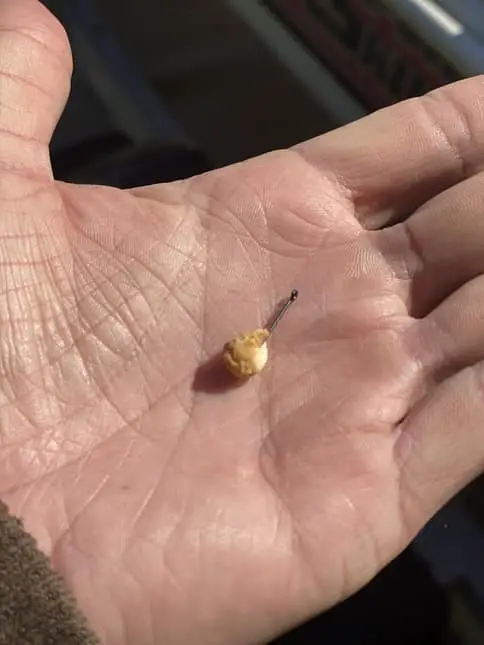
If you want to catch mullet, try bread!
Chumming For Mullet
Another effective method of baiting mullet is luring them to your fishing area by chumming food particles in the water. This method works especially well if you’re trying to cast net for mullet.
There are unlimited options for consideration if you opt for this approach, both organic and processed. Chicken mash, oatmeal, or breadcrumbs are all effective bait materials to chum for mullet.
Do Mullet Eat Corn?
Wild mullet are less likely to feed on corn. However, in residential ponds and fish farm operations, corn and other grain mashes are fed to mullet.
What Do Fish Farm Mullet Feed On?
Mullet are not exclusively caught in the wild; they are also farmed in ponds and shallow coastal waters enclosed in net barriers. Mullet farmers have a choice between natural foods, fish pellets, or both.
Natural foods that can be fed to farmed mullet include cereals like bran, wheat, corn, boiled rice, and millet. They also feed on earthworms and maggots. Pellets often supplement these food options to help balance nutritional requirements.
Ingredients of fish pellets for the omnivorous mullet fish are as diverse as the numerous food sources they enjoy in the wild. Their concentration can be manipulated to suit the farmer’s goals which is how farmed mullet get bigger faster.
Examples of fish pellet components are fishmeal, fish oil, groundnut oil cakes, soybean cake meal, and the cereals mentioned above.
You May Also Like: Mullet vs Whiting…What’s The Difference?

Growing up in Florida, I’ve been surrounded by saltwater my entire life…and I love sharing my passion with others.
To learn more about why I started Saltwater Mecca, visit the ABOUT page.
Thank you for reading this article. Browse around & have some fun!

